Menus
- Beautiful and rebellious: 125 cm3 of vitamin orange
- Discovery
- In the saddle
- In the city
- Fast lanes
- Chassis – Braking
- Comfort / Duo
- Consumption
- Conclusion
Beautiful and rebellious: 125 cm3 of vitamin orange
The long-awaited 125 Duke is finally on display. A project in progress since 2008, this new model represents a gateway for the youngest into the KTM universe. Indeed, the Mattighofen firm relies on the reality of the market (half of motorcycle sales in France are 125) and on the European evolution of the A1 license, which allows people over 16 years of age access to 125 from 2013…
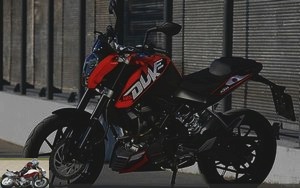
By introducing a strong aesthetic machine to this market, in line with the brand’s codes and its transgressive style, KTM wishes to appeal to young urban mobile people. As such, a vast personalization program makes it possible to follow the expectations of this target: to stand out and display the reference to a brand: global restyling stickers, accessories specific to the name of the brand (handles, discs, rim liner, etc. etc) and even LED ramps for tank…
In the same vein, dedicated clothing, with or without protection, completes this strategy.
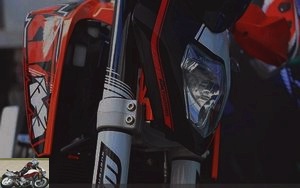
Discovery
The youngest does not deny the aesthetic affiliation with her big sisters: thin, stripped, angular and … orange! The illusion works well because you’d swear you’re dealing with a larger engine. But it is above all its almost flawless finish that impresses, completing the mimicry with the tenors of the Austrian brand’s range..
In fact, apart from a few electric wires and one or two mounting brackets, the 125 Duke is a chiseled miniature. Tubular steel frame, cast hollow aluminum swingarm, hydroformed steel handlebars. Suspension side: inverted WP fork of 43 mm (!), WP shock absorber adjustable in stress. For braking, 280mm front single disc with Bybre 4-piston radial caliper (By Brembo – standard designation for Indian production) and rear single-piston. Aluminum wheels, belly pan, taillights and LED indicators … what is left for the grown-ups? Their engine.
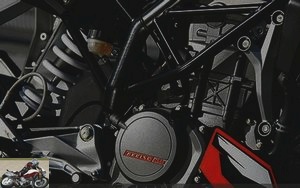
Because the new Duke adopts an all-new 124.7 cc, four-stroke single-cylinder engine block. The housings adopt the design of the LC4 engines, forcing the resemblance even further. The exhaust is placed under the engine and the gas plenum chamber in front of the shock absorber. According to the manufacturer, this engine cannot be optimized by tuning…
The manufacture of this 125 is provided by the Indian giant of the sector: Bajaj. The design remains of course Austrian.
In the saddle
The seat, with a height of 810 mm, allows as many people as possible to access the urban roadster-trail. Besides, the position is mixed. Footrests placed at the rear, body slightly tilted on a not so wide handlebars, narrow cockpit for tall riders. It smacks more of an attack between two fires than a door-to-door connection.
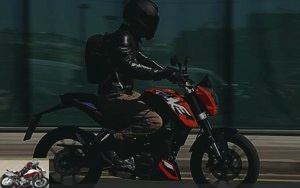
The fully digital counter is particularly complete … but difficult to read. Engine speed bar graph, gear indicator engaged, tachometer, odometer, clock, engine oil temperature, fuel gauge and two partials. Each of these successively displaying crossed information: consumption, km per liter…
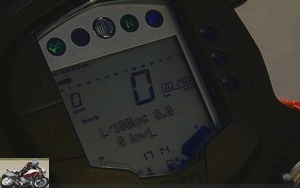
The commodos are standard but have the particularity of seeing their backlit icons … Unpublished. Easily adjustable, the mirrors unfortunately do not reflect a wide field of vision.
In the city
The illuminated orange meter initializes into a brush of liquid crystals. The single cylinder coughs and emits a muffled metallic noise. Appearances fall: it is indeed a 125…
Do not hesitate to accelerate frankly to obtain a dynamic displacement. We still regret a handful of gas with a fairly long draw which "breaks" the wrist..
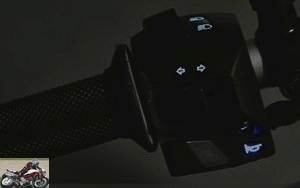
If the single cylinder is rather flexible, it is advisable to stay beyond 6,000 revolutions to obtain solid revivals on the third or fourth report. It is indeed these who will be most in demand in urban areas. However, you have to play the box regularly. This is unfortunately reluctant, imprecise and may require a slight break-in. As it is, it is sometimes painful to find a neutral point, or even complicated to come back to first after a stop in second.
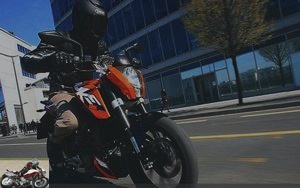
The 3rd rises very quickly to nearly 80 km / h, limited by the switch that turns on the shiftlight, to 10,500 revolutions / minute: more than enough on the boulevards. In doing so, we fully enter the fun space offered by the little Duke. Each traffic light is a start of the race, each interval between two tricolors an arsouille and the braking supported a call to the stunt: stopped, through…
Enduring, equipped with braided metal hoses, the radial caliper of the mini-KTM offers a substantial attack that will have to be managed on slippery roads. Equipped with an efficient fork, mass transfer is contained but the rear wheel is however quickly relieved.
Extremely rigid, this 125 fits to the millimeter. Extremely manoeuvrable, narrow, offering excellent balance, the bike sneaks around, dropping its rigged counterparts.
The fitting of Reuz FC tires from Indian tire manufacturer MRF does not call so much praise. Their perfectible grip, coupled with the sometimes dirty or greasy pavements of the capital cities, encourages a certain restraint.
Another point is fatigue in the long run: despite the presence of a balance shaft, the vibrations appear from 3,000 rpm and constantly increase with the increase in engine speed.
Fast lanes
Fitting easily on expressways limited to 80 km / h, the 125 Duke once again puts its cycle part in the spotlight. Rigorous in large, fast curves (110 km / h) with degraded coating, we appreciate the flawless chassis / suspension agreement. The maximum power is 15 hp (11.3 kW) at 10,500 rpm, and the torque is 1.2 daNm at 8,000 rpm.
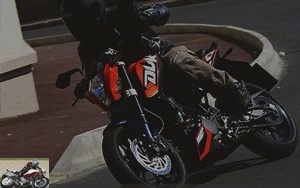
Chassis – Braking
The front axle is very precise. Particularly manoeuvrable, both in maneuver and in dynamics, this pocket Katoche benefits from a contained weight: 130 kilos.
Highlight of the novelty, the powerful Brembo system will require a bit of anticipation from novices.
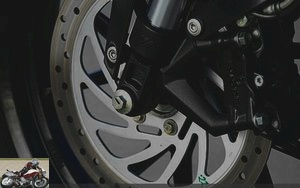
Comfort / Duo
The passenger seat is firm and narrow. If the handles offer good support, the footrests are perched high. Urban journeys will satisfy this geometry. The peri-urban may be less pleasant. Just like the position of the pilot which, over the kilometers, proves to be tiring for the older ones. Sensation accentuated by a hard saddle with sharp edges.
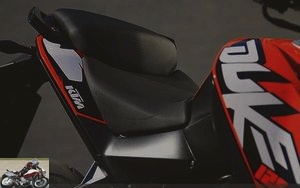
Consumption
The 11-liter tank and an average consumption of 3 liters will allow a range of over 300 kilometers. The injection, set very lean, causes jerking when going around and when stopping can cause the engine to stall.
Conclusion
With no real competition in terms of image, performance, equipment and finishes, the 125 Duke is a phenomenon in a dynamic segment. Other than the duller Derbi DRD 125 and the breathtaking but less efficient MH 125 NK1, the new KTM won’t get much shade. The forecast of 1,000 copies sold (between May 2011 and the end of the year) will undoubtedly be achieved.
Displayed at the price of 3.890 €, the little orange "plague" will surely invade cities quickly.
It is also rumored that a 250 cm3 version would be more than sketched out … Enough to further boost the color of cities and make peripheral trips fun. To be continued…
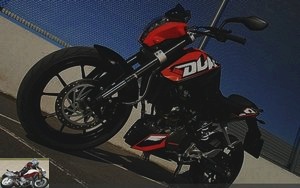
Strong points
- Motor character and flexibility
- Performance of the cycle part
- Efficient braking
- Strong aesthetics
- Finishes
Weak points
- Vibrations
- Perfectible gearbox
- Tire assembly
Duke 125 tech. Sheet
Related articles
-
Triumph Speed Triple 1050 motorcycle test
Rebel gentleman ! Since its creation, the Speed Triple has taken the classic aesthetic codes of THE virile motorcycle. In 1994, the English brand…
-
Roamer vs. Bobber: quite a movie ! The two-headed eagle ! Faced with the rise in range, displacement and power of competing models in the neo retro…
-
BMW F 900 R and F 900 XR comparison test
The evolutions of the 850 with the look of the 1000XR sport trail and the R1250R roadster Inline twin, 895 cm3, 105 hp, 92 Nm, Euro5, 211 and 219 kg BMW…
-
Comparison test for KTM 690 SMC-R and Enduro R motorcycles
Mono multi-pleasures Single cylinder LC4, 690 cm, 74 hp and 73.5 Nm, WP suspensions, Brembo brakes, 10,799 euros The very DNA of the brand, the…
-
Benelli Imperiale 400 motorcycle test
EVO Classic 374 cc single cylinder, 21.1 hp, 29 Nm, 205 kg, 4,399 euros Benelli is the oldest existing brand in Italy. But we should no longer say…
-
KTM 390 Adventure motorcycle test
Reverse osmosis Single cylinder, 373.2 cm3, 43.5 hp and 37 Nm, 172 kg full made, 6,699 euros For a long time the market was the queen of medium and large…
-
Royal Enfield 650 Interceptor and Continental GT test
Authentic (r) evolution Twin-cylinder in-line, 648 cm3, 47 hp and 52 Nm, 198 kg dry, double tubular cradle frame At the end of 2018, Santa Claus is…
-
Triumph Speed Triple 955i motorcycle test
Warning ! Nasty roadster ! Is it necessary to present the Speed Triple? Jewel of the English brand, the big three legs roadster is present in all the…
-
Royal Enfield Meteor 350 motorcycle test
Entry-level, extra class Air / oil single cylinder, 349 cm3, 20 hp and 27 Nm, 191 kg full made, from 4.099 euros Royal Enfield commemorates its 120th…
-
At maturity If the Duke 3 was an exotic outsider against classic roadsters, this fourth generation largely deserves its place in the family and is a…
Yeah, it’s still impractical and messy compared to a belt for a machine mainly intended for work-to-sleep trips.
It especially allows to use the skeleton of the X ADV without rethinking everything.
Worse a chain allows a less massive rear. On a bathtub, it matters.
Finally, on a big scooter already full of plastic, a chain guard would not have harmed the whole.
Beautiful CR, and (like what I do not just criticize) much more pleasant to read than sometimes (is it the same author ?? )
)
After Harley, Triumph, TMax, I bought a Forza 750. After a few months, I confirm: it is by far the best compromise ever. Scooter to fetch a baguette at 1 km, motorbike to arsouiller in the virolos. However, I do not share the analysis: this is not a GT. Non-adjustable windshield, nothing practical for hooking up your GPS, a little too high and insufficiently comfortable to make long routes in duo. Not convinced either by the house top case, with the disappointing basic finish and whose keyless opening system is not very practical .
The chain, a subject that initially concerned me, is not a problem except for heavy riders. For the rest, finally a two-wheeler with which you can have fun while driving quietly.
Finally and the bikers you are the last to have gear changes dating from prehistoric times !! Yeah we are men !! and quite precisely: paddles on the steering wheel on real cars, electric derailleurs on bikes, assistance from hell everywhere for the pleasure of piloting !! So on the bike !!!!
Peterbaldglobe: I think, on the contrary, a motorcycle should keep a manual gearbox. It’s part of the charm of the motorcycle, knowing how to manage your clutch, its gear changes is part of mastering your machine.
All electronic aids are mainly there to save time and for safety. Of course, a sequential gearbox is more precise and faster than a manual, but if you look closely, the motogp, SBK, TT, all that, they have no automatic gearbox, but manual with shifter, anti drible , TC (to scratch for seconds) … they could do it, but where is the point? It’s not funny. I drove an automatic and a sequential car before and was pissing myself off. I prefer my poor manual punto.
A car box is good when you don’t want to worry. That’s what scooters work for. Easier to go to work. Otherwise, you just have an ugly 2-wheeler with a mower noise.
Nice, the report
Nice, the javascript report: editor_tools_handle_smiley_select (" ")
")
I have been riding the SH for two years and 45,000 km and I find that this report reflects exactly how I felt about this very good scooter … frankly the most practical and economical means of transport that I have been given to drive moreover it is very playful.
Big advantage with the SH, it does not interest thieves at all and offers almost identical performance to a tmax, with a displacement of 350 cm2 it would be perfect. mine has 31000 km no problem to report, just a battery to change.
It seems that you are spreading an erroneous information on my difference in weight between this kymco and the Tmax … this one apparently being 10 to 15 kg and not thirty!
Warning ! Yamaha communicates on full weight and Kymco on dry weight !
AK 550 227 kg dry + 12.5 petrol + .5 oil = 240 kilos +/- 1 kg (and sometimes dry means without battery, in which case + 1.5kg)
[www.lerepairedesmotards.com]
Tmax: 213 kilos fully packed
[www.lerepairedesmotards.com]
We didn’t have time to go weigh them to get the real weights together, but we will do it to confirm.
For the record gasoline has a weight of 0.755 kg per liter.
So for 12.5 L we have 9.4 kg and not 12.5 as you count.
it’s already 3 kilos less.
Then the price comparison (1700 €) is not worth.
The Kymco has accessories (heated grips, tire pressures …) that the basic T-Max does not have.
We arrive at more than 2000 € difference to equivalent equipment.
Strongly that I have it !!!
the next evolution of Tmax will be ….. a car! with all the comforts that go with it and so the price can drop, because there, almost 14,000 for the model recommended by the lair, you might as well take a cheaper car that consumes less!